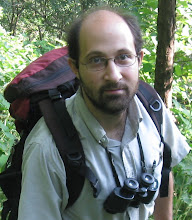 I took this picture this afternoon. More than a month earlier, and nearly 100 miles north. Of course, I believe this daisy, which is spreading rampantly from a few my mom planted many years ago in our backyard, may be a hybrid, which could explain some of its early blooming. I have not been privileged to live in one place continuously as an adult, so I have not been able to make careful observations of how the seasons are changing as a result of climate change. Returning to Amherst in May for the first time in 12 years has offered a bit of a shock. Somewhere, I have some fairly detailed naturalist notes I made as a middle and high school student, and could verify these timings, but my memory is that the apple orchard bloomed in mid May - maybe peaking between May 10th and 15th. Trees were definitely not leafed out in early May, perhaps reaching full leaf only by May 20th. Daffodils would be blooming in early May. Bobolinks returned around the same time as full leaf out - around the 15th or 20th. Hermit thrushes, black-throated green and blue-winged warblers, and chimney swifts returned a little earlier - perhaps corresponding to the apple blossoms on the 10th to the 15th.
I took this picture this afternoon. More than a month earlier, and nearly 100 miles north. Of course, I believe this daisy, which is spreading rampantly from a few my mom planted many years ago in our backyard, may be a hybrid, which could explain some of its early blooming. I have not been privileged to live in one place continuously as an adult, so I have not been able to make careful observations of how the seasons are changing as a result of climate change. Returning to Amherst in May for the first time in 12 years has offered a bit of a shock. Somewhere, I have some fairly detailed naturalist notes I made as a middle and high school student, and could verify these timings, but my memory is that the apple orchard bloomed in mid May - maybe peaking between May 10th and 15th. Trees were definitely not leafed out in early May, perhaps reaching full leaf only by May 20th. Daffodils would be blooming in early May. Bobolinks returned around the same time as full leaf out - around the 15th or 20th. Hermit thrushes, black-throated green and blue-winged warblers, and chimney swifts returned a little earlier - perhaps corresponding to the apple blossoms on the 10th to the 15th.I came back to Amherst on May 4th. That morning, I jogged down the Lawrence Swamp access road, behind my house. The apple blossoms were finished, the trees were fully leafed out, the daffodils in mom's garden were finished. I heard bobolinks bubbling in the meadows, blue-winged warblers calling from the hedgerows, and black-throated green warblers and hermit thrushes singing in the hemlocks.
These informal observations seem to indicate that the onset of spring in New England has advanced approximately 15 days since I was in high school - a startlingly rapid rate of about a day per year.

No comments:
Post a Comment